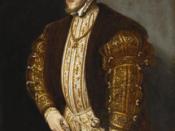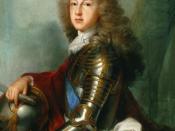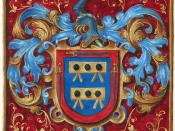Section 1: Spain
- The Spanish Empire reached its height during the reign of Charles's son, Philip II, who became king in 1556.
- In 1580, Philip II of Spain enforced his claim to the Portuguese throne by invading and conquering the country.
- Spain gained control of the Philippine Islands during the late 1500's.
- Spain also fought to defend western Europe from the expanding Ottoman Empire. Philip's rule brought the beginning of the Golden Age of Spanish art, a time when writers and painters created some of Spain's greatest artistic works.
- Although Philip ruled a worldwide empire and Spain was the strongest nation in Europe, signs of strain began to appear.
- Wars, inflation, and poor economic management weakened the country's economy. Philip's attempts to slow or stop the advance of Protestantism in Europe met serious opposition from the Netherlands and England. In the 1560's, the Netherlands rebelled against Spain.
In 1588, Philip II launched a great Spanish Armada of about 130 ships in an unsuccessful attempt to conquer England. English ships repelled the armada, and storms destroyed many of the Spanish ships during the retreat.
- Only about two-thirds of the armada made it back to Spain.
- In the 1600's, Spain was weakened by wars, rebellions, economic crises, and weak rulers.
- Fighting in the Netherlands continued into the early 1600's. Spain heavily financed the Roman Catholic cause in the Thirty Years' War (1618-1648).
- It also fought wars with France and faced rebellions in Portugal and the region of Catalonia in northern Spain.
- The last Spanish Habsburg, Charles II, had no children of his own.
- In 1700, he named a French duke, Philip of Anjou, as heir to the Spanish throne. Philip was a grandson of France's King Louis XIV, who reigned...



Help
does anyone know what france introduced to great britian in 1778?
3 out of 3 people found this comment useful.